Learning How To Learn Piano Scales is a rewarding journey that unlocks dexterity, enhances musical understanding, and ultimately boosts your playing ability. At LEARNS.EDU.VN, we’re dedicated to helping you master this fundamental skill, offering tailored guidance and resources to make the process enjoyable and effective. Discover the different types of scales, fingering techniques, and practice strategies to become a proficient pianist, improving sight-reading, and ear training.
1. Understanding Piano Scales
Scales are a sequence of notes arranged in ascending or descending order, following a specific pattern of intervals. Think of them as musical ladders, with each step representing a note. The starting note of a scale is called the root, and the scale is named after it, such as C major or A minor. Mastering scales is crucial for developing finger dexterity, understanding key signatures, and improving sight-reading skills. As cited by the Royal Conservatory of Music, regular scale practice enhances technical proficiency and musical expression.
1.1. What are Piano Scales?
Piano scales are ordered sequences of musical notes, ascending or descending in a stepwise fashion. The most common scales are major and minor, but there are also various other types, each with its unique pattern of whole and half steps. Understanding these patterns is key to playing scales accurately and fluently.
1.2. Why Piano Scales are Important?
Learning piano scales offers numerous benefits, including:
- Enhanced Finger Dexterity: Regular practice strengthens your fingers, making them quicker and more agile.
- Improved Technique: Scales help you master essential piano techniques, such as finger crossing and thumb tucking.
- Understanding Key Signatures: Learning scales familiarizes you with the relationships between notes and key signatures.
- Better Sight-Reading: Knowing scales makes it easier to recognize and play musical patterns in sheet music.
- Musical Expression: Scales provide a foundation for improvisation and creative expression.
1.3. Basic Scale Structure
All scales, whether major or minor, are constructed using a specific pattern of whole steps (W) and half steps (H).
- Half Step: The shortest distance between two adjacent keys on the piano (e.g., C to C# or E to F).
- Whole Step: Equal to two half steps, moving two keys in either direction (e.g., C to D or G to A).
Understanding these intervals is fundamental to building scales correctly.
2. Types of Piano Scales
There are many types of piano scales, each with its unique sound and application. Let’s explore some of the most common ones:
2.1. Major Scales
Major scales have a bright, cheerful sound and are often used in happy and uplifting music. The pattern for a major scale is:
Root – W – W – H – W – W – W – H
2.1.1. C Major Scale
The C major scale is a great starting point because it consists entirely of white keys. Its pattern is:
C – D – E – F – G – A – B – C
2.1.2. D Major Scale
The D major scale starts on D and follows the same whole and half-step pattern as C major. However, to maintain the correct pattern, it includes two sharps: F# and C#. The D major scale is:
D – E – F# – G – A – B – C# – D
2.1.3 Major Scale Chart
| Key | Notes |
|---|---|
| C Major | C D E F G A B C |
| G Major | G A B C D E F# G |
| D Major | D E F# G A B C# D |
| A Major | A B C# D E F# G# A |
| E Major | E F# G# A B C# D# E |
| B Major | B C# D# E F# G# A# B |
| F# / Gb Maj | F# G# A# B C# D# E# F# / Gb Ab Bb Cb Db Eb F Gb |
| Db Major | Db Eb F Gb Ab Bb C Db |
| Ab Major | Ab Bb C Db Eb F G Ab |
| Eb Major | Eb F G Ab Bb C D Eb |
| Bb Major | Bb C D Eb F G A Bb |
| F Major | F G A Bb C D E F |
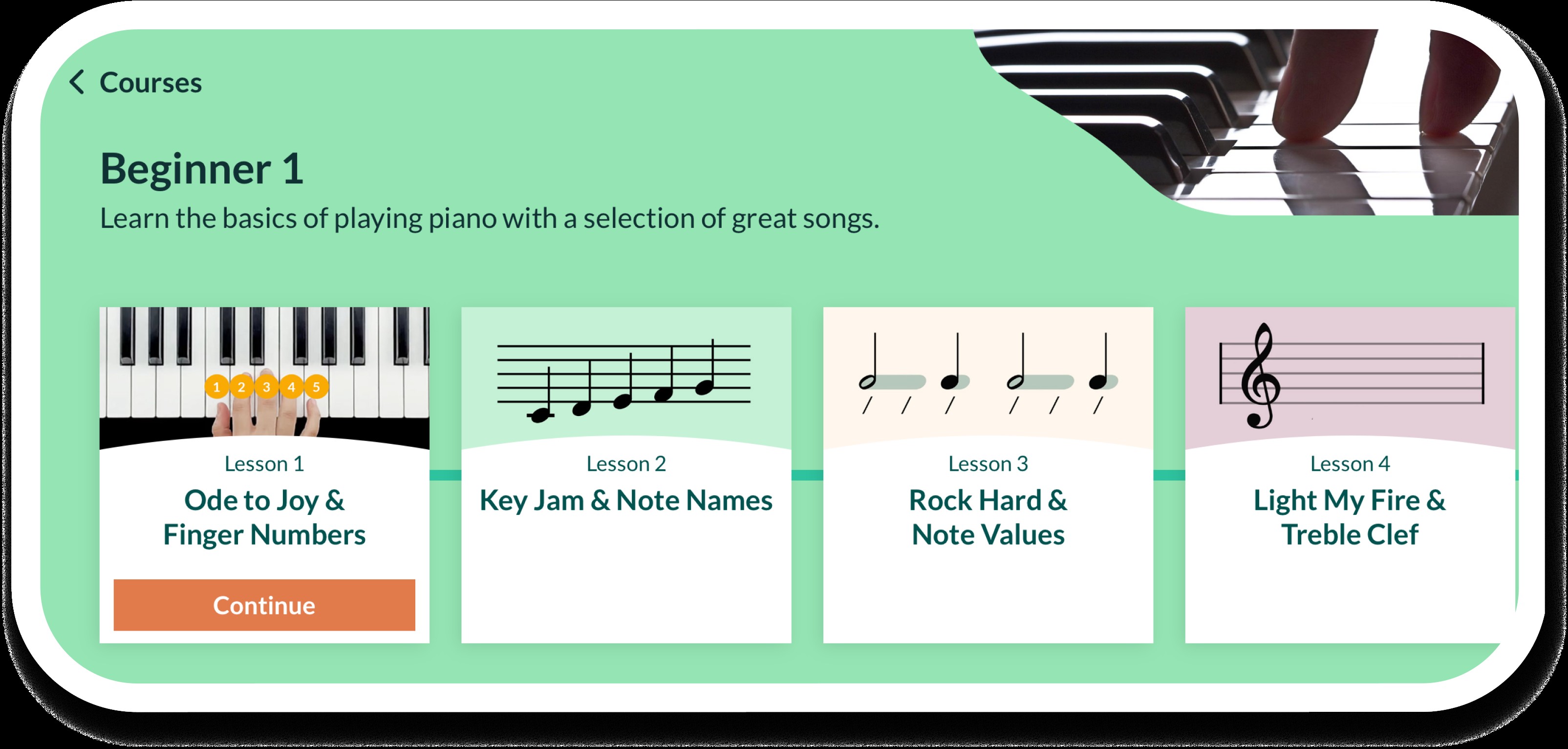

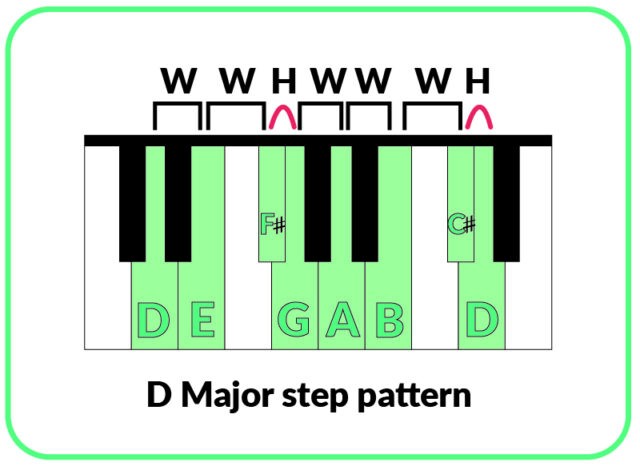
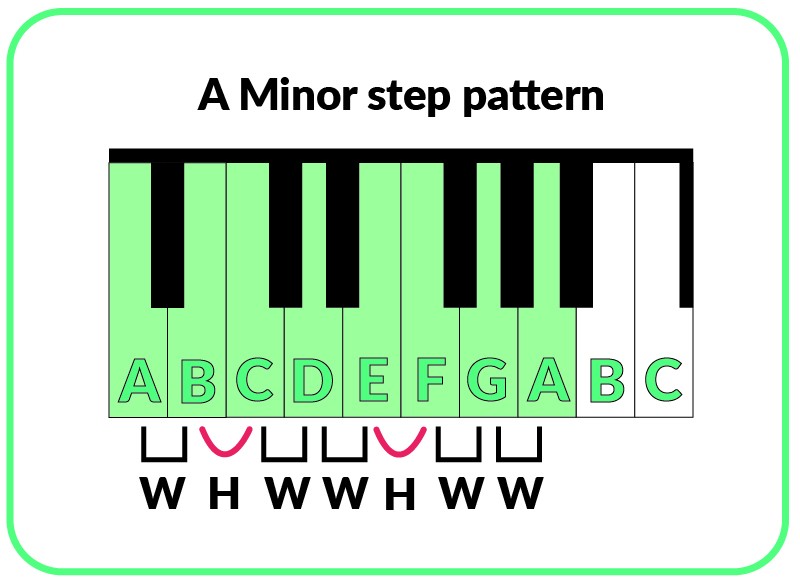
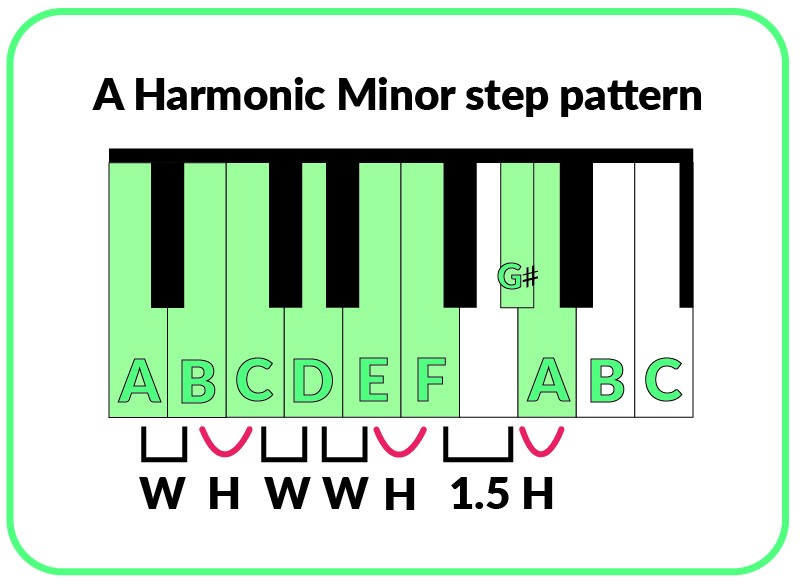
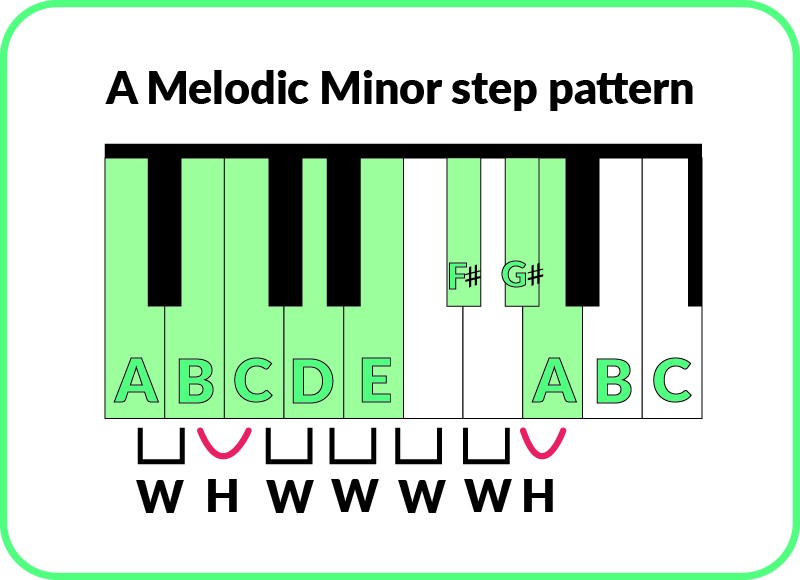
2.2. Minor Scales
Minor scales are often described as sounding sad, mysterious, or exotic. They are used to express a wider range of emotions compared to major scales.
2.2.1. Natural Minor Scale
The natural minor scale, also known as the Aeolian mode, has the following pattern:
Root – W – H – W – W – H – W – W
For example, the A natural minor scale is:
A – B – C – D – E – F – G – A
2.2.2. Harmonic Minor Scale
The harmonic minor scale is similar to the natural minor, but with a raised 7th degree. This creates a distinctive sound often used in classical and Middle Eastern music. The pattern is:
Root – W – H – W – W – H – 3 Half Steps – H
The A harmonic minor scale is:
A – B – C – D – E – F – G# – A
2.2.3. Melodic Minor Scale
The melodic minor scale has different ascending and descending forms. Ascending, it raises both the 6th and 7th degrees; descending, it reverts to the natural minor form. The patterns are:
- Ascending: Root – W – H – W – W – W – W – H
- Descending: Root – W – W – H – W – W – H – W
The A melodic minor scale is:
- Ascending: A – B – C – D – E – F# – G# – A
- Descending: A – G – F – E – D – C – B – A
2.3. Chromatic Scales
A chromatic scale includes every half step, moving through all available tones. It doesn’t conform to a specific key, but rather explores the full range of pitches.
The pattern for a chromatic scale is simply a series of half steps:
Root – H – H – H – H – H – H – H – …
2.4. Pentatonic Scales
Pentatonic scales consist of only five notes, making them easy to play and improvise with. They are commonly used in blues, jazz, and folk music.
2.4.1. Major Pentatonic Scale
The major pentatonic scale is structured as follows:
Root – W – W – 3 Half Steps – W – 3 Half Steps
The C major pentatonic scale is:
C – D – E – G – A
2.4.2. Minor Pentatonic Scale
The minor pentatonic scale has a bluesy feel. The pattern is:
Root – 3 Half Steps – W – W – 3 Half Steps – W
The C minor pentatonic scale is:
C – Eb – F – G – Bb
2.5. Whole Tone Scale
The whole tone scale, composed entirely of whole steps, creates a dreamy, ethereal sound. Claude Debussy frequently used this scale in his compositions. The pattern is:
Root – W – W – W – W – W – W
The C whole tone scale is:
C – D – E – F# – G# – A# – C
3. How to Practice Piano Scales Effectively
Knowing the types of scales is only the first step. The real challenge is mastering them through consistent and effective practice.
3.1. Proper Hand Position and Fingering
Maintaining a good hand position is essential for playing scales smoothly and efficiently. Your fingers should be curved slightly downwards, hovering above the keys, with a relaxed wrist.
- Fingering for C Major: The standard fingering for the C major scale is 1-2-3-1-2-3-4-5 (where 1 = thumb, 2 = index finger, 3 = middle finger, 4 = ring finger, 5 = pinky).
- Fingering for Other Scales: Some scales have different fingerings due to the presence of black keys. Be sure to learn the correct fingering for each scale to ensure smooth and accurate playing.
3.2 Practicing Hands Together
Playing scales hands together can be challenging at first, but it’s crucial for developing coordination and musicality. Start slowly, focusing on synchronizing your hands and maintaining a relaxed posture.
3.3. Contrary Motion Scales
Practicing scales in contrary motion (one hand ascending while the other descends) is a great way to improve coordination and develop advanced technique.
3.4. Tips for Effective Practice
- Consistency is Key: Practice scales daily, even if it’s just for a few minutes.
- Start Slowly: Focus on accuracy and evenness of tone before gradually increasing speed.
- Use a Metronome: A metronome helps you maintain a steady tempo and improve your timing.
- Vary Your Practice: Don’t just play scales in the same way every time. Try different rhythms, dynamics, and articulations.
- Listen Actively: Pay attention to the sound of your playing and make adjustments as needed.
- Take Breaks: Avoid practicing for too long at a time, as this can lead to fatigue and injury.
4. Memorizing Piano Scales
Memorizing scales is essential for developing fluency and musical understanding. Here are some tips to help you memorize scales effectively:
- Play Regularly: Repetition is key to memorization. Play each scale several times a day.
- Visualize the Pattern: Try to visualize the pattern of whole and half steps in each scale.
- Use Key Signatures: Learn the key signatures for each scale to help you remember which notes are sharp or flat.
- Practice in Order: Practice scales in order of key signatures (e.g., C major, G major, D major) to reinforce your understanding of key relationships.
- Look Away from Your Hands: Try to play scales without looking at your hands to develop muscle memory.
5. Integrating Scales into Your Playing
Once you’ve mastered the basics of scales, it’s time to integrate them into your playing.
5.1. Improvisation
Use scales as a foundation for improvisation. Experiment with different rhythms, melodies, and harmonies within the framework of a scale.
5.2. Composition
Incorporate scales into your compositions. Use them to create melodies, harmonies, and chord progressions.
5.3. Learning New Pieces
When learning a new piece, identify the scales that are used in the music. Practicing those scales will make it easier to learn and perform the piece.
6. Advanced Scale Techniques
Once you’ve mastered the basics, you can explore more advanced scale techniques to further enhance your playing.
6.1. Arpeggios
Arpeggios are broken chords, where the notes of a chord are played in sequence rather than simultaneously. Practicing arpeggios is a great way to develop finger dexterity and coordination.
6.2. Inversions
Inversions involve playing scales starting on different notes within the scale. This can help you develop a deeper understanding of scale patterns and improve your finger dexterity.
6.3. Double Scales
Double scales involve playing two scales simultaneously, either in unison, parallel motion, or contrary motion. This is a challenging but rewarding technique that can greatly improve your coordination and musicality.
7. Utilizing Technology for Scale Practice
Technology can be a powerful tool for enhancing your scale practice.
7.1. Piano Learning Apps
Apps like Skoove offer interactive lessons and real-time feedback to help you learn and practice scales effectively.
7.2. Online Resources
Websites like Pianoworld provide interactive tools and resources for learning scales.
7.3. Digital Piano Features
Many digital pianos offer features like built-in metronomes, recording capabilities, and interactive lessons that can enhance your practice experience.
8. The Role of LEARNS.EDU.VN in Your Musical Journey
At LEARNS.EDU.VN, we are committed to providing you with the resources and support you need to master piano scales and achieve your musical goals. We offer:
- Detailed Guides: Comprehensive articles and tutorials on various types of scales and practice techniques.
- Expert Advice: Guidance from experienced piano teachers and musicians.
- Interactive Tools: Online resources and tools to help you learn and practice scales effectively.
- Personalized Learning Plans: Customized study plans tailored to your individual needs and goals.
We believe that anyone can learn to play the piano with the right guidance and dedication. Visit our website at LEARNS.EDU.VN to explore our resources and start your musical journey today.
9. Common Challenges and How to Overcome Them
Learning piano scales can present several challenges. Here’s how to tackle them:
- Difficulty with Fingering: Focus on practicing fingering patterns slowly and consistently until they become automatic.
- Lack of Coordination: Start by practicing hands separately, then gradually combine them, focusing on synchronizing your movements.
- Loss of Motivation: Set realistic goals, track your progress, and find ways to make practice fun and engaging.
- Physical Discomfort: Ensure you have proper posture and hand position to avoid strain or injury. Take frequent breaks and stretch your hands and wrists regularly.
10. The Future of Piano Education and Scales
The future of piano education is increasingly digital, with online resources, apps, and interactive tools making learning more accessible and engaging than ever before. At LEARNS.EDU.VN, we are committed to staying at the forefront of these trends, providing you with the latest and most effective methods for learning piano scales and achieving your musical aspirations.
10.1. Emerging Trends in Music Education
- Personalized Learning: Tailoring instruction to individual needs and learning styles.
- Gamification: Incorporating game-like elements to make learning more fun and engaging.
- Virtual Reality: Using VR technology to create immersive and interactive learning experiences.
- AI-Powered Tutors: Utilizing artificial intelligence to provide personalized feedback and guidance.
10.2. Integrating New Technologies into Scale Practice
- Motion Sensors: Using sensors to track your hand movements and provide feedback on your technique.
- AI-Driven Feedback: Receiving personalized feedback on your timing, accuracy, and expression.
- Interactive Learning Platforms: Engaging with online platforms that adapt to your skill level and learning pace.
10.3 Latest education trends
| Topic | Description |
|---|---|
| Microlearning | Breaking down complex topics into small, easily digestible segments. |
| Personalized Learning Paths | Tailoring the educational experience to meet the unique needs and goals of each student. |
| AI in Education | Using artificial intelligence to personalize learning, automate tasks, and provide data-driven insights. |
| Virtual Reality | Immersive educational experiences that allow students to interact with 3D environments. |
| Blockchain in Education | Secure and transparent record-keeping of student achievements and qualifications. |
| Gamification | Using game-like elements to make learning more engaging and fun. |
| Focus on Soft Skills | Emphasis on teaching skills like communication, collaboration, and critical thinking. |
| Project-Based Learning | Students learn by actively working on real-world projects. |
| Online Learning | Flexible and accessible education through online courses, webinars, and virtual classrooms. |
| Adaptive Testing | Assessments that adjust difficulty based on student performance, providing a more accurate measure of knowledge. |
FAQ: Your Questions About Learning Piano Scales Answered
- How long does it take to learn piano scales?
- The time it takes to learn piano scales varies depending on your dedication and practice habits. With consistent practice, you can master the basics in a few months.
- What is the best way to start learning scales?
- Start with the C major scale, as it consists entirely of white keys and is relatively easy to learn.
- Do I need a teacher to learn scales?
- While a teacher can provide valuable guidance, it is possible to learn scales on your own using online resources and practice tools.
- What are the most important scales to learn?
- The major and minor scales are the most fundamental and widely used.
- How often should I practice scales?
- Aim to practice scales daily, even if it’s just for 15-20 minutes.
- What if I’m struggling with a particular scale?
- Break the scale down into smaller sections and practice each section slowly and deliberately.
- Can I use scales in my own compositions?
- Absolutely! Scales are a great foundation for creating melodies, harmonies, and chord progressions.
- What are some common mistakes to avoid when practicing scales?
- Avoid using excessive tension, rushing through the scale, and neglecting proper fingering.
- How can I make scale practice more fun?
- Try playing scales in different rhythms, dynamics, and articulations. Experiment with improvisation and composition.
- Where can I find more resources for learning piano scales?
- Visit LEARNS.EDU.VN for detailed guides, expert advice, and interactive tools to help you master piano scales.
Conclusion: Embark on Your Musical Journey Today
Learning piano scales is a rewarding journey that opens up a world of musical possibilities. By understanding the different types of scales, mastering proper technique, and practicing consistently, you can develop the skills and knowledge you need to become a proficient pianist.
At LEARNS.EDU.VN, we’re here to support you every step of the way. Whether you’re a beginner or an experienced player, our comprehensive resources and personalized guidance can help you achieve your musical goals.
Don’t let the challenges of learning scales hold you back. Embrace the opportunity to unlock your musical potential and discover the joy of playing the piano. Visit LEARNS.EDU.VN today to explore our resources, connect with our community, and start your musical journey.
Contact Us:
- Address: 123 Education Way, Learnville, CA 90210, United States
- WhatsApp: +1 555-555-1212
- Website: LEARNS.EDU.VN
Start your musical journey with learns.edu.vn and discover the transformative power of piano scales. Let’s create music together!
